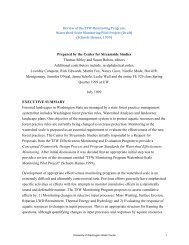Copyright 2012 Aileen M. Echiverri-Cohen - University of Washington
Copyright 2012 Aileen M. Echiverri-Cohen - University of Washington
Copyright 2012 Aileen M. Echiverri-Cohen - University of Washington
Create successful ePaper yourself
Turn your PDF publications into a flip-book with our unique Google optimized e-Paper software.
ain regions associated with a wide range <strong>of</strong> executive functions may reflect inhibitory<br />
dysfunctions in behavioral performance and clinical symptoms in PTSD.<br />
Although major neurobiological models address inhibitory dysfunction in PTSD (e.g.,<br />
inescapable shock, van der Kolk, Greenberg, Boyd, & Krystal, 1985; kindling, Friedman, 1988),<br />
one <strong>of</strong> the earliest models connecting impaired inhibitory control to the prefrontal cortex and<br />
amygdala was a neuropsychological model posited by Kolb (1987). Kolb proposed that PTSD<br />
results from excessive stimulation in brain structures including the amygdala that, in turn,<br />
promotes sensitization and disrupts activity in the frontal executive systems responsible for<br />
inhibiting cortical and subcortical structures. Expanding upon Kolb's original hypothesis, others<br />
have argued further for deficient inhibitory control by the mPFC over the amygdala in PTSD<br />
(Rau, DeCola, & Fanselow, 2005; Pitman, Shin & Rauch, 2001; Charney, 2004).<br />
Both sensitization, an increase in reactivity to potent stimuli after repeated exposure over<br />
time (e.g., Groves & Thompson, 1976), and kindling, repeated subthreshold stimulation leading<br />
to increased reactivity (e.g., Goddard, McIntyre, & Leech, 1969), have been posited to account<br />
for deficient top-down control by the mPFC on the amygdala. Accordingly, the functional<br />
connectivity network made up <strong>of</strong> the prefrontal cortex and subcortical structures, such as the<br />
amygdala (Gilboa et al., 2004), may reflect neural substrates <strong>of</strong> inhibition. The functionally<br />
deficient inhibitory networks are presumed to have a negative effect on information processing<br />
(Bremner et al., 1993). The mPFC and anterior cingulate are involved in a range <strong>of</strong> executive<br />
functions including error monitoring, and detecting failures <strong>of</strong> the executive system in carrying<br />
out goal-directed processing <strong>of</strong> information (Hajcak & Simons, 2008, Lavie, Hirst, de Fockert, &<br />
Viding, 2004). Consequently, a functionally deficient mPFC may indicate a dysfunction in<br />
inhibitory mechanisms necessary for regulating information processing. This is consistent with<br />
5
















